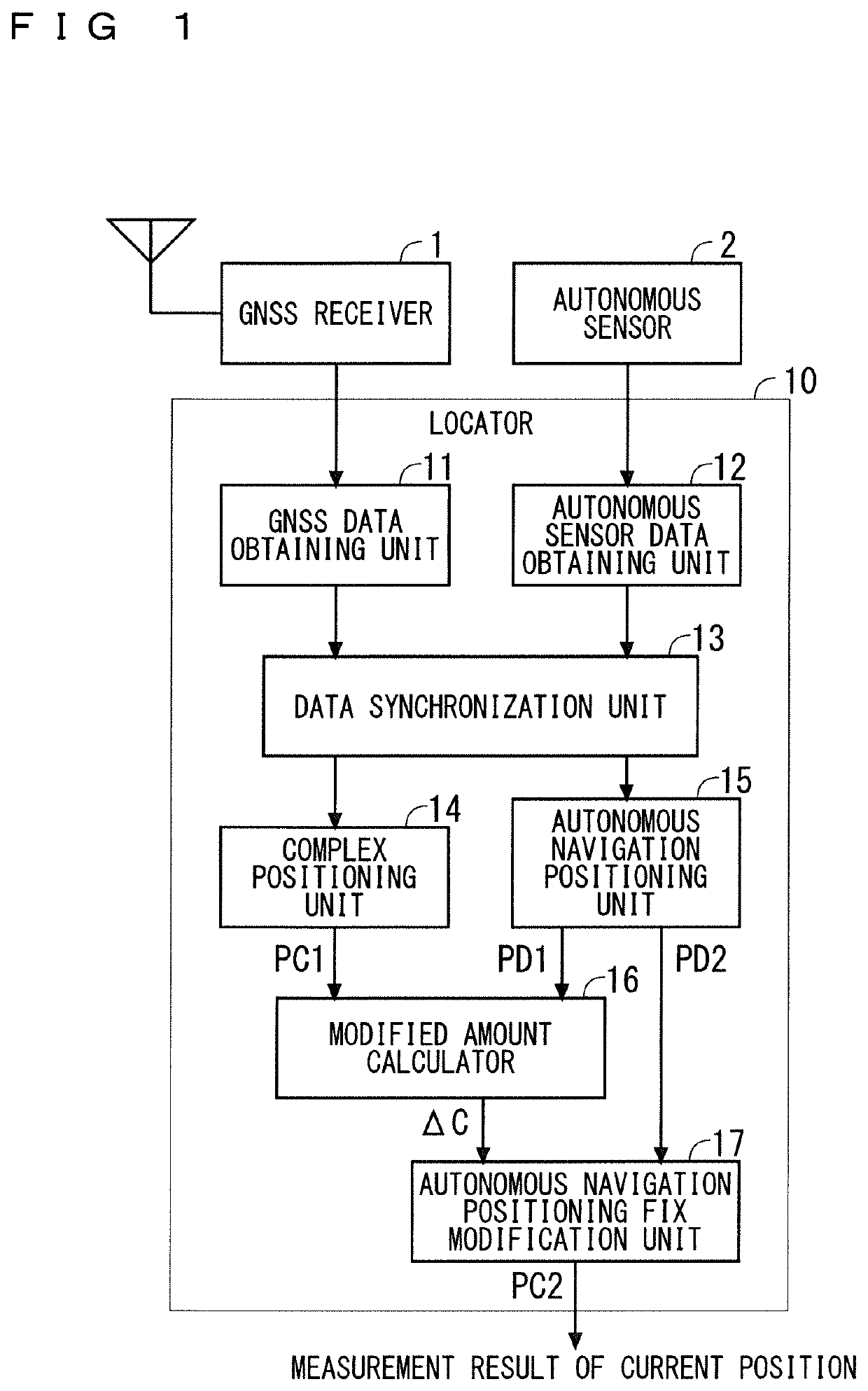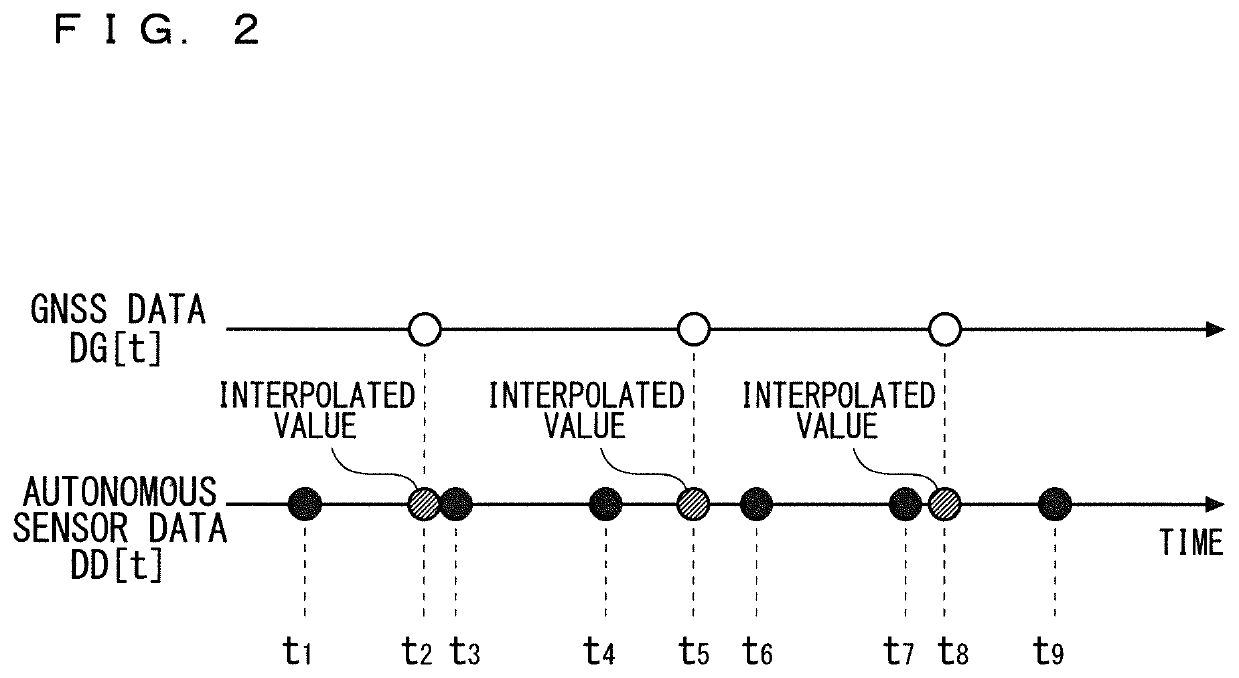Locator, accuracy evaluation system therefor, and positioning method
- Summary
- Abstract
- Description
- Claims
- Application Information
AI Technical Summary
Benefits of technology
Problems solved by technology
Method used
Image
Examples
embodiment 1
[0026]FIG. 1 illustrates a configuration of a positioning system according to Embodiment 1. As illustrated in FIG. 1, the positioning system includes a GNSS receiver 1, an autonomous sensor 2, and a locator 10. The assumption in Embodiment 1 is that the positioning system is loaded onto a vehicle. Hereinafter, the vehicle onto which the positioning system is loaded will be referred to as a “subject vehicle”. A part or the entirety of the positioning system need not be always loaded onto the subject vehicle, but may be, for example, constructed in a mobile device such as a mobile phone, a smartphone, or a portable navigation device. Although the configuration of the system shows the locator 10 externally equipped with the GNSS receiver 1 and the autonomous sensor 2, the locator 10 may include the GNSS receiver 1 and the autonomous sensor 2.
[0027]The GNSS receiver 1 receives a satellite signal transmitted from a GNSS satellite, decode the satellite signal to retrieve raw data, and out...
embodiment 2
[0066]In the locator 10 according to Embodiment 1, the accuracy of the time of the GNSS data is important because it influences the accuracy of the modified amount (ΔC) of autonomous navigation that is calculated by the modified amount calculator 16. Embodiment 2 proposes the GNSS receiver 1 that enables the locator 10 to accurately record the time of the GNSS data.
[0067]As described above, the GNSS receiver 1 performs a decoding process for retrieving the GNSS data (raw data) from the satellite signal, and a positioning process using the GNSS data (GNSS positioning). Since the GNSS data is large in amount and requires a certain time for the positioning process, there is a time lag since the GNSS receiver 1 receives the satellite signal and outputs the GNSS data until the locator 10 obtains the GNSS data.
[0068]According to Embodiment 2, the GNSS receiver 1 is configured to output a notification to the locator 10 at a time T1 of receiving the satellite signal and starting to decode t...
embodiment 3
[0074]FIG. 10 illustrates a configuration of an accuracy evaluation system for the locator 10 according to Embodiment 3. The configuration of the positioning system in FIG. 10 is obtained by further connecting a survey instrument 3, a reference data obtaining unit 18, and an accuracy evaluation unit 19 to the locator 10 in the configuration of FIG. 1. The locator 10 may include the reference data obtaining unit 18 and the accuracy evaluation unit 19.
[0075]The survey instrument 3 receives a satellite signal transmitted from a GNSS satellite, and performs positioning more accurately than the GNSS receiver 1, using the GNSS data (raw data) retrieved from the satellite signal. The positioning performed by the survey instrument 3 is not limited to the GNSS positioning. For example, when the survey instrument 3 includes an accurate autonomous sensor, the survey instrument 3 may perform the complex positioning using autonomous sensor data obtained by the autonomous sensor. Hereinafter, the...
PUM
 Login to View More
Login to View More Abstract
Description
Claims
Application Information
 Login to View More
Login to View More - R&D
- Intellectual Property
- Life Sciences
- Materials
- Tech Scout
- Unparalleled Data Quality
- Higher Quality Content
- 60% Fewer Hallucinations
Browse by: Latest US Patents, China's latest patents, Technical Efficacy Thesaurus, Application Domain, Technology Topic, Popular Technical Reports.
© 2025 PatSnap. All rights reserved.Legal|Privacy policy|Modern Slavery Act Transparency Statement|Sitemap|About US| Contact US: help@patsnap.com



